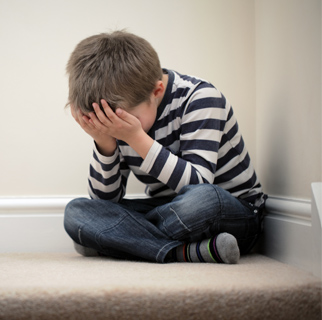Helping Kids Get Over their Fears

Who’s afraid of the big, bad wolf? When you were age 4 or 5, you probably were. If you have children this age, you can count on them being fearful of wild animals, monsters, and the dark.
But have no fear. It’s a normal part of their development. You need the experience of mastering fear as a child to be competent as an adult. If you think of sports success as being the result of practice, then it's easy to understand why learning to master your fears is a good thing.
Almost all children have fears. Some of the most common fears are of bugs or ghosts. And kids are afraid of pretty much the same things, no matter where in the world they live.
What are those common fears, and when do they typically turn up in children’s lives?
Typical fears of infants and young children
-
Babies are afraid of objects coming toward them, and sudden noises. They also are wary of strangers, although that depends on their family and how much they’re around other people.
-
Toddlers' fears center on their relationship with their parents and fears of being left alone. They feel separation anxiety. They will go off to play but will constantly check back with the parent. They recognize they are vulnerable.
-
Preschool-aged kids, there's the fear of animals, snakes, the dark, and monsters. At this age, they can’t always separate what’s reality and what’s fantasy in their minds. If they dreamed it, it really did happen. This is the age when nightmares occur.
-
For school-aged children, their fears are in terms of self-concept. They may worry if they will pass a test? Or will the other children like them? They may also fear getting sick, natural disasters, and harm to self or others.
Typical fears of older children
-
At age 7, fears grow out of ideas suggested by TV and movies, performance in school, or dark spaces.
-
At ages 8 and 9, school or personal failure, ridicule by peers, and disease are common fears.
-
At ages 10 to 12, children often fear heights, criminals, older kids, parental anger, and remote possibilities of catastrophe and school failure.
-
During adolescence, youths may fear social affairs, death, and illness.
-
Older teens tend to express fear about changes in their bodies, isolation, sex, and world events.
Whatever you do, don’t force children to face a fear unless they want to. It would be wrong, for instance, to put children who are afraid of snakes into a room full of snakes without preparing them for the experience.
What you can do
If you know in advance about a situation that will most likely upset your child, plan ahead. If you're moving, introduce your child to the new home beforehand, if you can. If you're taking a vacation without your children, make sure the babysitter comes to the house a lot before the vacation.
Diversions are another tactic for offsetting fearful events. If your child is going to your healthcare provider's office for a shot, try doing something fun or interesting on the way home. Or bring some favorite books to the office to read.
What's important is to find solutions that are appropriate to children. Be sure you've tuned into your child's emotions, not your own. Then find ways that work to cope with those fears from the child's point of view. For example, if your child is afraid of the dark, you might:
-
Add a nightlight to the room
-
Do a "monster check" each day
-
Get a stuffed animal that’s designed to fight monsters
-
Help your child develop a routine to deal with the fear
-
Keep the door cracked open
Above all, remember to keep things in perspective. A lot of normal fears are going to pass, given time. The child who is terrified of monsters and can’t get to sleep for a month will say 6 months later, "Gee, I used to be afraid of monsters."
One kid's fright is another's delight
Imagine a box sitting on a table. You are asked to reach into the box through a hole just big enough for your hand. You do. Something grabs your hand. How would you react?
As a child, you'd probably have had 1 of 3 reactions when you discovered it was a puppet that grabbed your hand:
-
You'd be totally delighted and laugh
-
You'd be startled, but would put your hand back in to let the puppet shake it
-
You’d be frightened and refuse to go anywhere near the box again
Kids with similar experiences can have very different responses. They may be fearful for several reasons:
-
A previous frightening experience
-
Exposure to scary information, such as in the media
-
Inherited tendency
-
Observation of fear reaction in others
-
Temperament
Watch your reaction
If you say, "That must’ve been scary," you are reinforcing the children’s reality.
Another choice is to help children see that their own ideas affect how they see the situation. For example, you might say, "Let’s go see the puppet. Oh, this is really neat."
Children who laugh at the puppet clearly see novel events as a source of humor. This reinforces their view of the world as a fun, interesting place. That's likely to make things a lot easier for them growing up.
Parents or caregivers should get professional help if children’s fears significantly get in the way of the activities of daily living.